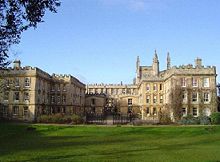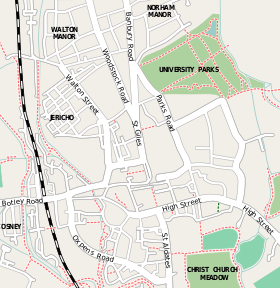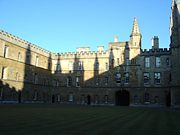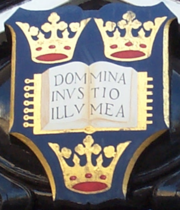New College, Oxford

|
|
||||||||||||
| College name | New College of St Mary | |||||||||||
| Latin name | Collegium Novum Oxoniense/Collegium Sanctae Mariae Wintoniae | |||||||||||
| Named after | Mary, mother of Jesus | |||||||||||
| Established | 1379 | |||||||||||
| Sister college | King's College, Cambridge | |||||||||||
| Warden | Prof. Alan Ryan; Warden from September 2009 will be Professor Sir Curtis Price | |||||||||||
| JCR president | Matthew Ranger | |||||||||||
| Undergraduates | 420 | |||||||||||
| MCR president | Thomas Adcock | |||||||||||
| Graduates | 180 | |||||||||||
|
|
||||||||||||
 Location of New College within central Oxford |
||||||||||||
| Homepage | ||||||||||||
| Boatclub | ||||||||||||
New College is one of the constituent colleges of the University of Oxford in the United Kingdom. Its official name, College of St Mary, is the same as that of the older Oriel College; hence, it has been referred to as the "New College of St Mary", and is now almost always called "New College". One of the most famous and academically successful of the Oxford colleges, it stands along Holywell Street and New College Lane (known for Oxford's Bridge of Sighs), next to All Souls College, The Queen's College and St Edmund Hall. It is one of the main choral foundations of the University of Oxford. In 2006 the college had an estimated financial endowment of £143m.[1] In 2006 New College sold some of these assets to provide a substantial salary windfall for its fellows (among other uses).[2].
Contents |
History
Despite its name, New College is one of the oldest of the Oxford colleges, having originally been founded in 1379. The second college in Oxford to be dedicated to the Blessed Virgin Mary, it was founded by William of Wykeham, Bishop of Winchester. It was founded in conjunction with the famous Winchester College, which was envisaged as a feeder to the Oxford college, and the two institutions have striking architectural similarities: both were the work of master mason William Wynford. Both Winchester College and New College were originally established for the education of priests, there being a shortage of properly educated clergy after the Black Death. William of Wykeham also established New College School to provide for the education of 16 choristers for the chapel.
As well as being the first Oxford college for undergraduates and the first to have senior members of the college give tutorials, New College was the first college in Oxford to centre on a main quadrangle, with student rooms, a dining hall, a library, and study rooms within the square ring of buildings and gates. The quadrangle design inspired many of the later colleges, perhaps most recently St Catherine's College, Oxford because Arne Jacobsen was an ardent admirer of "the Oval", or oval-shaped lawn in the old quad. (New College's quadrangle is not the first in Oxford, however, merely the first to contain all of the above elements; the first quadrangle was Merton's Mob Quad. Merton's dining hall, though, is in a connecting building outside the quad, as is its chapel.)
At the time of its founding, New College had the grandest collection of buildings for a college in Oxford, a testament to Wykeham's experience in administering both ecclesiastical and civil institutions as the Bishop of Winchester and High Chancellor of England.
The New College grounds are among the largest and most beautiful in Oxford. The Cloisters and the Chapel are of particular note, as is the old City Wall (around which the College is built); much of the mediæval stained glass in the antechapel has recently been restored. The gardens are equally impressive and include the decorative Mound (which originally had steps, but is now smooth with one set of stairs).
The bell tower contains one of the oldest rings of ten bells, which is rung by the Oxford Society of Change Ringers and the Oxford University Society of Change Ringers. The college is also in possession of a respectable collection of silver (including the mediæval silver gilt Founder's Crozier, housed in a display case in the chapel), and two notable "unicorn horns" (in fact narwhal tusks).
In addition to its academic reputation and its impressive set of buildings, New College is internationally renowned for its chapel choir. As part of the original College statutes, William of Wykeham provided for a choral foundation of lay and academical clerks, with boy choristers to sing mass and the daily offices. It is a tradition that continues today with the choral services of evensong and eucharist during term. In addition to its choral duties in the chapel, the choir has established a reputation as one of the finest Anglican choirs in the world through its many recordings and concert tours. The chapel organ was built by the firm of Grant, Degens, and Bradbeer in 1969, in a case designed by George Pace; somewhat revolutionary at the time, the instrument remains no less remarkable and idiosyncratic today.
Motto
The College's motto, created by William of Wykeham, is "Manners Makyth Man". The motto was in many respects fairly revolutionary. Firstly, it was written in English, rather than Latin, which makes it very unusual in Oxford, and is especially revolutionary considering the College's age; even St Catherine's College, founded in 1965, has a Latin motto ("Nova et Vetera": "the new and the old").
Secondly, the motto makes a social statement. While it might initially seem to be suggesting that it is beneficial to have good manners, this does not really capture its full scope. What it really means is that it is not by birth, money, or property that an individual is defined, but by how he (or she) behaves towards other people.
Wardens
See List of Wardens of New College, Oxford.
People associated with the College
There are a number of notable individuals who have studied at New College, including churchmen, statesmen, and literary figures. The Professorial Fellowships which the College holds include the Charles Simonyi Professor in the Public Understanding of Science, which was held by Richard Dawkins.[3]
- See also Former students of New College and Fellows of New College
Gallery

Holywell Street, New College, Oxford.
|

The old quad of New College, Oxford.
|

Gate leading to the gardens of New College, Oxford.
|
|

College chapel and part of the Old Buildings.
|

Inside the chapel of New College, Oxford.
|

New College Lane, Oxford.
|

Old college and city wall of New College, Oxford.
|
References
- ↑ Oxford College Endowment Incomes, 1973-2006 (updated July 2007)
- ↑ Windfall for dons after £55m land sale
- ↑ "Academic Staff" (HTML). Retrieved on 2008-03-27.
External links
- New College, Oxford
- Arcadia Redux - 2007 New College Commemoration Ball
- New College JCR, Oxford
- New College MCR, Oxford
- College choir
- A history of the choristers of New College, Oxford
|
|||||||||
